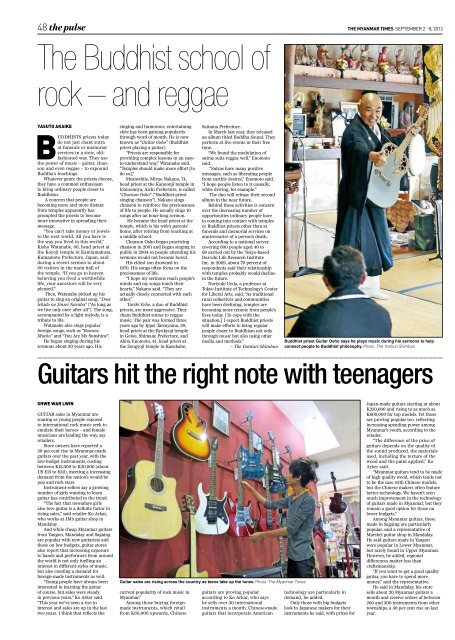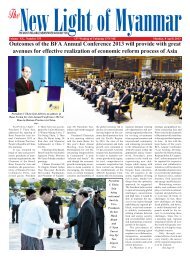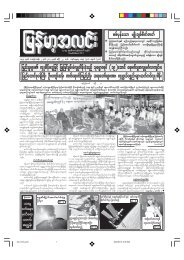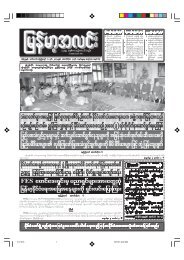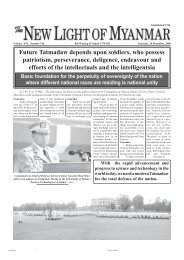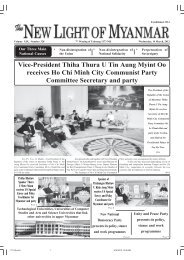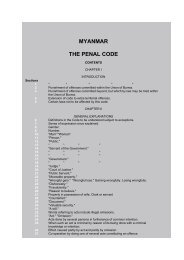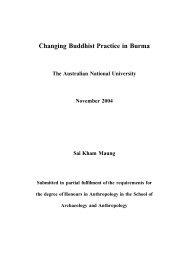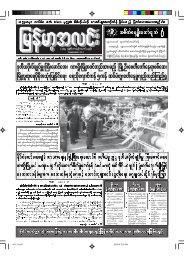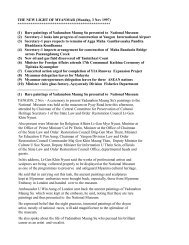Presidential adviser sues 13 farmers for trespassing - Online Burma ...
Presidential adviser sues 13 farmers for trespassing - Online Burma ...
Presidential adviser sues 13 farmers for trespassing - Online Burma ...
Create successful ePaper yourself
Turn your PDF publications into a flip-book with our unique Google optimized e-Paper software.
48 the pulse THE MYANMAR TIMES SEPTEMBER 2 - 8, 20<strong>13</strong><br />
The Buddhist school of<br />
rock – and reggae<br />
Yasuto Akaike<br />
BUDDHISTS priests today<br />
do not just chant sutra<br />
at funerals or memorial<br />
services in a stoic, oldfashioned<br />
way. They use<br />
the power of music – guitar, chanson<br />
and even reggae – to expound<br />
Buddha’s teachings.<br />
Whatever genre the priests choose,<br />
they have a common enthusiasm<br />
to bring ordinary people closer to<br />
Buddhism.<br />
A concern that people are<br />
becoming more and more distant<br />
from temples apparently has<br />
prompted the priests to become<br />
more innovative in spreading their<br />
message.<br />
“You can’t take money or jewels<br />
to the next world. All you have is<br />
the way you lived in this world,”<br />
Kisho Watanabe, 66, head priest at<br />
the Koyoji temple in Kamiamakusa,<br />
Kumamoto Prefecture, Japan, said<br />
during a recent sermon to about<br />
60 visitors in the main hall of<br />
the temple. “If you go to heaven<br />
believing you lived a worthwhile<br />
life, your ancestors will be very<br />
pleased.”<br />
Then, Watanabe picked up his<br />
guitar to sing an original song, “Dose<br />
Ichido no Jinsei Naraba” (“As long as<br />
we live only once after all”). The song,<br />
accompanied by a light melody, is a<br />
tribute to life.<br />
Watanabe also sings popular<br />
<strong>for</strong>eign songs, such as “Besame<br />
Mucho” and “You Are My Sunshine”.<br />
He began singing during his<br />
sermons about 20 years ago. His<br />
singing and humorous, entertaining<br />
style has been gaining popularity<br />
through word of mouth. He is now<br />
known as “Guitar Osho” (Buddhist<br />
priest playing a guitar).<br />
“Priests are responsible <strong>for</strong><br />
providing complex lessons in an easyto-understand<br />
way,” Watanabe said.<br />
“Temples should make more ef<strong>for</strong>t [to<br />
do so].”<br />
Meanwhile, Miruo Nakano, 74,<br />
head priest at the Kannonji temple in<br />
Ichinomiya, Aichi Prefecture, is called<br />
“Chanson Osho” (“Buddhist priest<br />
singing chanson”). Nakano sings<br />
chanson to rein<strong>for</strong>ce the preciousness<br />
of life to people. He usually sings 10<br />
songs after an hour-long sermon.<br />
He became the head priest at the<br />
temple, which is his wife’s parents’<br />
home, after retiring from teaching at<br />
a middle school.<br />
Chanson Osho began practicing<br />
chanson in 2001 and began singing in<br />
public in 2004 so people attending his<br />
sermons would not become bored.<br />
His eldest son drowned in<br />
1970. His songs often focus on the<br />
preciousness of life.<br />
“I hope my sermons reach people’s<br />
minds and my songs touch their<br />
hearts,” Nakano said. “They are<br />
actually closely connected with each<br />
other.”<br />
Tariki Echo, a duo of Buddhist<br />
priests, are more aggressive. They<br />
chant Buddhist sutras to reggae<br />
music. The pair was <strong>for</strong>med three<br />
years ago by Ippei Tatsuyama, 39,<br />
head priest at the Ryukyoji temple<br />
in Gotsu, Shimane Prefecture, and<br />
Akira Enomoto, 41, head priest at<br />
the Zengyoji temple in Kasukabe,<br />
Saitama Prefecture.<br />
In March last year, they released<br />
an album titled Buddha Sound. They<br />
per<strong>for</strong>m at live events in their free<br />
time.<br />
“We found the modulation of<br />
sutras suits reggae well,” Enomoto<br />
said.<br />
“Sutras have many positive<br />
messages, such as liberating people<br />
from earthly desires,” Enomoto said.<br />
“I hope people listen to it casually,<br />
while driving, <strong>for</strong> example.”<br />
The duo will release their second<br />
album in the near future.<br />
Behind these activities is concern<br />
over the decreasing number of<br />
opportunities ordinary people have<br />
in coming into contact with temples<br />
or Buddhist priests other than at<br />
funerals and memorial services on<br />
anniversaries of a person’s death.<br />
According to a national survey<br />
covering 600 people aged 40 to<br />
69 carried out by the Tokyo-based<br />
Dai-ichi Life Research Institute<br />
Inc. in 2009, about 70 percent of<br />
respondents said their relationship<br />
with temples probably would decline<br />
in the future.<br />
Noriyuki Ueda, a professor at<br />
Tokyo Institute of Technology’s Center<br />
<strong>for</strong> Liberal Arts, said, “As traditional<br />
rural collectives and communities<br />
have been declining, temples are<br />
becoming more remote from people’s<br />
lives today. [To cope with the<br />
situation,] I expect Buddhist priests<br />
will make ef<strong>for</strong>ts to bring regular<br />
people closer to Buddhism not only<br />
through music but also using other<br />
media and methods.”<br />
– The Yomiuri Shimbun<br />
Buddhist priest Guitar Osho says he plays music during his sermons to help<br />
connect people to Buddhist philosophy. Photo: The Yomiuri Shimbun<br />
Guitars hit the right note with teenagers<br />
Shwe War Lwin<br />
GUITAR sales in Myanmar are<br />
soaring as young people exposed<br />
to international rock music seek to<br />
emulate their heroes – and female<br />
musicians are leading the way, say<br />
retailers.<br />
Store owners have reported a<br />
30 per cent rise in Myanmar-made<br />
guitars over the past year, with the<br />
low-budget instruments, costing<br />
between K15,000 to K30,000 (about<br />
US $15 to $30), meeting a increasing<br />
demand from the nation’s would-be<br />
pop and rock stars.<br />
Instrument-sellers say a growing<br />
number of girls wanting to learn<br />
guitar has contributed to the trend.<br />
“The fact that nowadays girls<br />
also love guitar is a definite factor in<br />
rising sales,” said retailer Ko Arkar,<br />
who works at JM’s guitar shop in<br />
Mandalay.<br />
And while cheap Myanmar guitars<br />
from Yangon, Mandalay and Sagaing<br />
are popular with new guitarists and<br />
those on low budgets, guitar stores<br />
also report that increasing exposure<br />
to bands and per<strong>for</strong>mers from around<br />
the world is not only fuelling an<br />
interest in different styles of music,<br />
but also creating a demand <strong>for</strong><br />
<strong>for</strong>eign-made instruments as well.<br />
“Young people have always been<br />
interested in learning the guitar<br />
of course, but sales were steady<br />
in previous years,” Ko Arker said.<br />
“This year we’ve seen a rise in<br />
interest and sales are up in the last<br />
two years. I think that reflects the<br />
Guitar sales are rising across the country as teens take up the tunes. Photo: The Myanmar Times<br />
current popularity of rock music in<br />
Myanmar.”<br />
Among those buying <strong>for</strong>eignmade<br />
instruments, which retail<br />
from K60,000 upwards, Chinese<br />
guitars are proving popular<br />
according to Ko Arkar, who says<br />
he sells over 30 international<br />
instruments a month. Chinese-made<br />
guitars that incorporate American<br />
technology are particularly in<br />
demand, he added.<br />
Only those with big budgets<br />
look to Japanese makers <strong>for</strong> their<br />
instruments he said, with prices <strong>for</strong><br />
Japan-made guitars starting at about<br />
K250,000 and rising to as much as<br />
K600,000 <strong>for</strong> top models. Yet those<br />
are proving popular too, reflecting<br />
increasing spending power among<br />
Myanmar’s youth, according to the<br />
retailer.<br />
“The difference of the price of<br />
guitars depends on the quality of<br />
the sound produced, the materials<br />
used, including the texture of the<br />
wood and the paint applied,” Ko<br />
Arker said.<br />
“Myanmar guitars tend to be made<br />
of high quality wood, which tends not<br />
to be the case with Chinese models,<br />
but the Chinese makers often feature<br />
better technology. We haven’t seen<br />
much improvement in the technology<br />
of guitars made in Myanmar, but they<br />
remain a good option <strong>for</strong> those on<br />
lower budgets.”<br />
Among Myanmar guitars, those<br />
made in Sagaing are particularly<br />
popular, said a representative of<br />
Marshel guitar shop in Mandalay.<br />
He said guitars made in Yangon<br />
were popular in Lower Myanmar,<br />
but rarely found in Upper Myanmar.<br />
However, he added, regional<br />
differences matter less than<br />
craftsmanship.<br />
“If you want to get a good quality<br />
guitar, you have to spend more<br />
money,” said the representative.<br />
He said in Mandalay, his store<br />
sells about 20 Myanmar guitars a<br />
month and receive orders of between<br />
200 and 300 instruments from other<br />
townships, a 30 per cent rise on last<br />
year.


